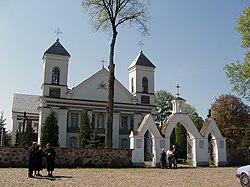Valkininkai
| Valkininkai | ||
|---|---|---|
| Town | ||

Church of Valikininkai
|
||
|
||
| Location in Varėna district municipality | ||
| Coordinates: 54°21′20″N 24°50′20″E / 54.35556°N 24.83889°ECoordinates: 54°21′20″N 24°50′20″E / 54.35556°N 24.83889°E | ||
| Country |
|
|
| County |
|
|
| Municipality | Varėna district municipality | |
| Eldership | Valkininkų (Valkininkai) | |
| Capital of | Valkininkai eldership | |
| First mentioned | 1387 | |
| Granted city rights | 1571, 1723, 1792 | |
| Population (2011 Census) | ||
| • Total | 229 | |
| Time zone | EET (UTC+2) | |
| • Summer (DST) | EEST (UTC+3) | |
Valkininkai (Polish: Olkieniki, Belarusian: Алькенікі) is a historic town in Valkininkų (Valkininkai) eldership, Varėna district municipality, Alytus County, Lithuania, located about 22 km (14 mi) northeast from Varėna and about 55 km (34 mi) southwest from Vilnius. At the 2001 census its population was 238 and at the 2011 census it was 229.
The town is situated on the confluence of Merkys River with its tributaries Šalčia and Geluža. About 8 km (5.0 mi) east of Valkininkai there is Valkininkų Geležinkelio Stotis, a settlement that grew around a train station on the Warsaw – Saint Petersburg Railway and now has more residents.
It is believed that Valkininkai was first mentioned in a letter from Grand Duke Jogaila to his brother Skirgaila in 1387. The settlement developed on a large island (since then disappeared) in Merkys River. Situated near the Hrodna–Varėna–Vilnius route, the settlement had a royal estate that Grand Dukes used as a hunting lodge. The route further grew in importance after the 1385 Union of Krewo as it connected the Lithuanian capital in Vilnius with the Polish capital in Kraków. In 1418, Grand Duke Vytautas the Great gifted the estate to his wife Juliana Olshanska. In 1503, the town was mentioned as a seat of a volost. In 1516, King Sigismund I the Old accepted envoys of Charles, King of Spain and future Holy Roman Emperor in Valkininkai.
...
Wikipedia



